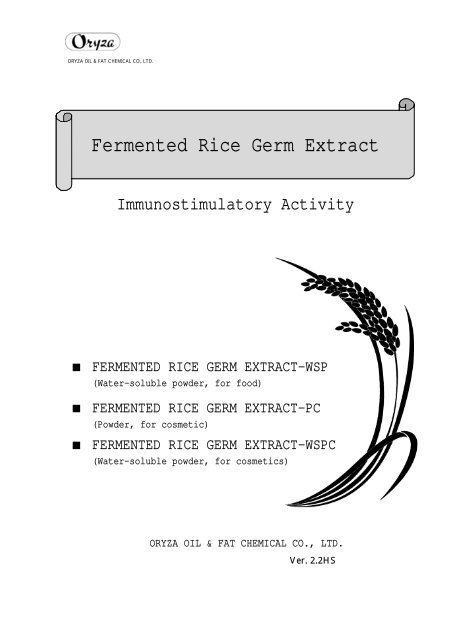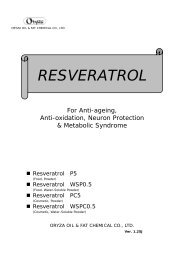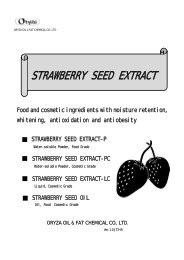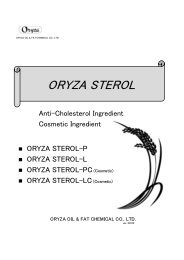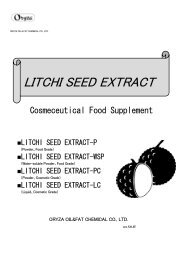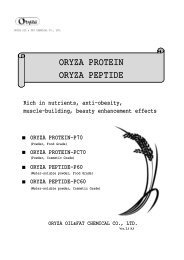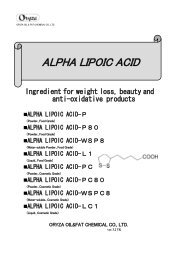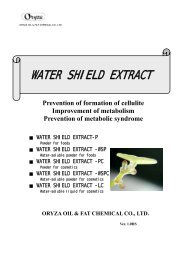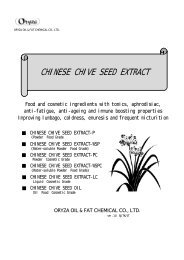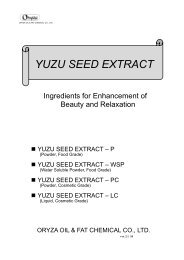Fermented Rice Germ Extract
Fermented Rice Germ Extract
Fermented Rice Germ Extract
You also want an ePaper? Increase the reach of your titles
YUMPU automatically turns print PDFs into web optimized ePapers that Google loves.
FERMENTED RICE GERM EXTRACT CATALOG ver. 2.2HS Ver. 2.2HS0
FERMENTED RICE GERM EXTRACT CATALOG ver. 2.2HSFERMENTED RICE GERM EXTRACTHealth Food Ingredients1. Introduction<strong>Rice</strong> (Oryza sativa) have been widely grown in the Southeast Asia, not only as achief crop but also as acts an integral part of traditional culture and lifestyle of someAsian countries. In recent years, much attention have been focused on rice bran and ricegerm, which are discharged in the process of the polished rice production, because of itcontains many unique bioactive compounds.In the course of our investigation on rice bran and rice germ for a long time, someproducts were developed by utilizing functional compounds containing in it, and havebeen used as medicines, cosmetics, health foods, and food additives.Fermentation is a traditional technique for food processing. At ORYZA OIL& FAT CHEMICAL CO., LTD., we have found that fermented rice germ generatesfunctional components that successfully stimulate the immune system. Using ourextraction and purification technique, “FERMENTED RICE GERM EXTRACT” hasbeen produced on a commercial basis as a potential ingredient for foods.2. FermentationFermentation has traditionally been used as a food processing technique in Japan.Various fermented foods such as Miso paste, soy sauce, Natto (fermented soybeans),dried bonito flesh and pickles have been produced from rice, soybeans or otheringredients by utilizing microorganisms, including yeasts, Bacillus natto (a strain of B.subtilis), lactic acid bacteria and Aspergillus. In Western countries, some fermentedfoods such as cheeses, breads, beer and wine have been made to extend shelf life.These fermented foods have recently attracted attention not merely as food items1
FERMENTED RICE GERM EXTRACT CATALOG ver. 2.2HSbut also as food with beneficial health-promoting functions.During fermentation, Aspergillus generates various enzymes that trigger de novosyntheses of certain components, which might exhibit a novel biological activity.(1) AspergillusAs shown in Fig. 1 Aspergillus is classified. The Aspergillus has been utilized inJapan to produce indigenous fermented foods such as alcoholic beverages (Sake andAwamori), Miso paste, soy sauce, Mirin (sweet rice wine used for cooking) and pickles.Fig. 1 Classified of Aspergillus2
FERMENTED RICE GERM EXTRACT CATALOG ver. 2.2HS(2) Components enriched by the fermentation of rice germIn the process of rice germ fermentation by Aspergillus, newly produced enzymescause catabolic changes, including digestion of starches and sugars as well ashydrolysis of proteins yielding amino acids and low molecular peptides.In addition, concentrations of phosphoserine (a phosphorylated serine), cysteineand cystine are increased. Ferulic acid content is elevated, leading to the synthesis ofdiferulic acid.It has been demonstrated that a phosphoserine-containing peptide exhibitsmitogenic activity in cultured cells derived from the spleen, Peyer’s patches and thymus(H. Otani, Faculty of Agriculture, Shinshu University, Proceedings of the fifthconference of Japanese Society for Mastitis).Cysteine and cystine are antioxidative agents. Besides being a component ofglutathione, which is an anti-cancer substance, cysteine has been found to enhancedetoxification activity in the liver and inhibit melanin synthesis, which facilitates themetabolism of the skin epidermal tissue. Some studies have demonstrated that bothferulic and diferulic acids have anti-oxidative and ultraviolet (UV)-absorbing properties.Ferulic acid has been recently investigated as a cancer preventive agent (Firstinternational symposium on disease prevention by IP-6 and other rice components).3
FERMENTED RICE GERM EXTRACT CATALOG ver. 2.2HS Fig. 2 Components enriched by the rice germ fermentation3. Immune systemThe body system that responds to a foreign substance such as pathogen or virus iscalled the immune system. Some substances have “immunostimulatory activity”,namely, a biological property to enhance this system.The immune system is mainly mediated by white blood cells. In particular,4
FERMENTED RICE GERM EXTRACT CATALOG ver. 2.2HSgranulocytes (neutrophils, eosinophils and basophils), macrophages and lymphocytes(natural killer NK cells, T cells and B cells) play important roles in the system.Macrophages act as scavengers. Once a macrophage engulfs a foreignsubstance including pathogens and viruses by phagocytosis, it detoxifies the substance.Moreover, the macrophage displays information about the substance and activates otherimmune cells.An activated NK cell spontaneously attacks the infected cells as well as thecancer cells and causes lethal damage to the targets by destroying the cell membrane.A foreign substance (bacterium or virus) entersthe body along with, for example, foods.The substance invades the capillary vessels viathe gastrointestinal mucous membrane, throughwhich nutrients are absorbed.The substance in the bloodstream is deliveredfrom the portal vein to the liver and spreadsthroughout the organs.The substance is engulfed, digested and detoxifiedby macrophages.NK cells cause the cancer cells lethal damageby destroying the cell membrane.Fig. 3The immune system in the body5
FERMENTED RICE GERM EXTRACT CATALOG ver. 2.2HS4. Potential function of FERMENTED RICE GERM EXTRACT1) Immunostimulatory activity(1) Preventing infections by enhancing the phagocytotic capacity of macrophages(in vitro)FERMENTED RICE GERM EXTRACT stimulates phagocytosis in macrophages,by which foreign viruses and bacteria are digested and detoxified.Using an in vitro assay system, we have found that FERMENTED RICE GERMEXTRACT markedly enhances the phagocytotic capacity of rat hepatic macrophagescompared to extracts derived from unfermented rice germ as well as from other plants.The results suggest that FERMENTED RICE GERM EXTRACT has a preventiveeffect against viral and bacterial infections in vivo. There were no significant differences observed among groups indicated by the samealphabetic character on the right side of bar. Phagocytotic capacity was indicated as apercent of the baseline value measured for each sample using intact macrophages whosephagocytotic capacity was not blocked.Fig. 4 The phagocytotic capacity of rat hepatic macrophages (final concentration of each substance being examined: 200 g/ml)6
FERMENTED RICE GERM EXTRACT CATALOG ver. 2.2HS(in vivo)During a two-week experimental period, Sprague-Dawley (SD) rats aged fiveweeks were administered daily oral dose of 200 mg of “FERMENTED RICE GERMEXTRACT” dissolved in 1 ml of saline, and exposed to light irradiation and waterswim stress.To examine the phagocytotic capacity, peritoneal macrophages weremixed with latex beads, subsequently dissolved and analyzed the turbidity incomparison with the saline-treated control group.The results demonstrate that“FERMENTED RICE GERM EXTRACT” attenuates the stress-induced damage inphagocytotic capacity of macrophages. This product will improve the immune system,which is vulnerable to aging, stress and environmental pollution, and prevent infectionswith invading viruses or bacteria. Relative maintenance of phagocytotic capacity was estimated as follows.Thedifference in values between an extract-treated group and the saline-treated controlwas calculated (a). The mean difference in values between the intact group and thesaline-treated control was also estimated (b).By defining “b” as 100%, weexpressed a percentage of “a” as the relative maintenance of phagocytotic capacity (%).Fig. 5The phagocytotic capacity of rat peritoneal macrophages7
FERMENTED RICE GERM EXTRACT CATALOG ver. 2.2HS(2) Preventing cancer by enhancing the cancericidal capacity of NK cells(in vitro)FERMENTED RICE GERM EXTRACT intensifies the cancericidal capacity ofNK cells. We confirmed in vitro that FERMENTED RICE GERM EXTRACTeffectively stimulates rat hepatic NK cells (Pit cells) to kill cancer cells compared tothat induced by extracts derived from unfermented rice germ and other plants. There was no significant difference observed among groups having the samealphabetic character on the right side of bar.NK cell activity is indicated as a percentage of lysed (killed) cells in the total target cancer cells.Fig.6 The cancericidal capacity of rat hepatic NK cells(final concentration of each substance being examined: 200 g/ml)8
FERMENTED RICE GERM EXTRACT CATALOG ver. 2.2HS(in vivo)Five-week-old SD rats were orally administered either 200 mg ofFERMENTED RICE GERM EXTRACT dissolved in 1 ml of saline or an equal volumeof saline, and subjected to water swim and light irradiation stress for two weeks.Splenic NK cells were obtained and co-cultured with mouse lymphoma cells (YAC-1).Cytotoxicity to YAC-1 cells was evaluated by analyzing lactate dehydrogenase (LDH)activity in the culture medium.The enzyme activity was expressed as a percent of themaximal LDH activity, which was measured when all YAC-1 cells were lysed.Weconcluded from the results that FERMENTED RICE GERM EXTRACT improves thecancericidal capacity of NK cells under stress situations.Namely, this extract willenhance immunity to cancer by stimulating NK cell activity, which is vulnerable toaging, stress and environmental pollution. Relative maintenance of cancericidal capacity was estimated as follows.Thedifference in values between an extract-treated group and the saline-treated controlwas calculated (a).The mean difference in values between the intact group andthe saline-treated control was also estimated (b).By defining “b” as 100%, weexpressed a percentage of “a” as the relative maintenance of cancericidal capacity (%)Fig. 7The cancericidal capacity of rat splenic NK cells9
FERMENTED RICE GERM EXTRACT CATALOG ver. 2.2HS2) Antioxidative activity (1,1-diphenyl-2-picrylhydrazyl [DPPH]radical scavenging activity and superoxide dismutase [SOD]-likeactivity)Enhanced DPPH radical scavenging and SOD-like activities were observedduring rice germ fermentation by Aspergillus. Both activities peaked on the third dayof fermentation. Fig.8 Sequential changes in DPPH radical scavenging activity during fermentation (final concentration of the substance being examined: 100 g/ml) Fig.9 Sequential changes in SOD-like activity during fermentation(final concentration of the substance being examined: 1,000 g/ml)10
FERMENTED RICE GERM EXTRACT CATALOG ver. 2.2HS3) Prolyl endopeptidase (PEP)-inhibitory activityIt has been reported that PEP accumulates in the brain and causes functionalimpairment in patients with Alzheimer’s disease. We found that the rice germfermentation by Aspergillus a strong PEP-inhibitory activity. Fig.10Sequential changes in PEP-inhibitory activity during fermentation(final concentration of the substance being examined: 1.9 mg/ml)4) Polyphenol contentDuring fermentation by Aspergillus, rice germ yields an increased amount ofpolyphenols, the concentration of which was maximized on the third day offermentation. Fig.11Sequential changes in polyphenol content during fermentation11
FERMENTED RICE GERM EXTRACT CATALOG ver. 2.2HS5. Stability of FERMENTED RICE GERM EXTRACT1) Thermal ResistanceThe pyrolysis of FERMENTED RICE GERM EXTRACT dose not occur at anormal food processing temperature for 60 minutes. Fig.12Fig.13Heat-Resistance of FERMENTED RICE GERM EXTRACT2) pH StabilityFERMENTED RICE GERM EXTRACT remained stable at wide range ofpH-field . Fig.14Fig.15Influence of pH on FERMENTED RICE GERM EXTRACT 12
FERMENTED RICE GERM EXTRACT CATALOG ver. 2.2HS6. Daily Dosage of FERMENTED RICE GERM EXTRACTFERMENTED RICE GERM EXTRACT (powder)200500mg/day7. Nutrition facts of FERMENTED RICE GERM EXTRACTItems AnalyzedResultWater3.4 g/100gProtein* 118.4 g/100gFat1.6g/100gAsh10.2 g/100gAvailable carbohydrate* 261.6 g/100gEnergy* 3334 kcal/100gDietary Fiber4.8 g/100gSodium38.2 mg/100g*1 N5.95*2 100-(Moisture + Protein + Fat + Ash + Dietary fiber)*3 Factors for calculating the energy value:Protein - 4, Fat - 9, Available carbohydrate - 4Tested by : Japan Food Research Center FoundationResearch result issue number : 301080468-0018. Acute toxicity of FERMENTED RICE GERM EXTRACTFive weeks old mice were orally given FERMENTED RICE GERM EXTRACT(5000mg/kg) and then fed a laboratory chow for two weeks. No toxic effect wereobserved, thus the LD50 (mice) is more than 5000 mg/kg.9. Practical Applications of FERMENTED RICE GERMEXTRACTApplicationsExamplesHealth foods Soft-capsule, Tablet, Hard-capsule, and so on .Candy, Gum, Gummi, Cookies, Chocolate, Wafers, Jelly,Food Drink, Soup, Dried Noodles, Seasoning, Bean paste, Soy sauce,Bread, Yogurt and so on.13
FERMENTED RICE GERM EXTRACT CATALOG ver. 2.2HS10. PackagingFERMENTED RICE GERM EXTRACT-P5kg Interior packaging: aluminum-coated plastic bagExterior packaging: cardboard boxFERMENTED RICE GERM EXTRACT-WSP5kg Interior packaging: aluminum-coated plastic bagExterior packaging: cardboard box11. Storing MethodStore in cool, dry place. Avoid humidity12. Expression of FERMENTED RICE GERM EXTRACTFERMENTED RICE GERM EXTRACT Please refer to your nation’s standards.14
FERMENTED RICE GERM EXTRACT CATALOG ver. 2.2HSMethods of ExperimentsFig. 4 The phagocytotic capacity of rat hepatic macrophages (in vitro)Hepatic macrophages were obtained from Wistar rats (12-14 weeks old). Afterliver perfusion with collagenase solution via the portal vein, macrophages were isolatedfrom the perfusate using an elutriation rotor and adhered to a culture platform.Prior to adding an extract to the culture medium, the phagocytotic capacity wasblocked. To measure phagocytosis, latex beads were added to the medium and thenumber of beads engulfed by one macrophage was counted under a phase contrastmicroscope.Phagocytotic capacity was indicated as a percent of the baseline value measured foreach sample using intact macrophages whose phagocytotic capacity was not blocked.Fig. 5Methods are described in the text.Fig. 6 The cancericidal capacity of rat hepatic NK cells (in vitro)Wistar rats (12-14 weeks old) were used in this study. Hepatic NK cells werecollected via the portal vein using a hyperbaric liver perfusion system, and purifiedthrough a column.NK cells were co-cultured with mouse lymphoma cells (YAC-1) in a mediumcontaining an extract. Cytotoxicity to YAC-1 cells was evaluated by analyzing lactatedehydrogenase (LDH) activity in the culture medium. When all YAC-1 cells werelysed, LDH activity was regarded as 100%.Fig. 7 Methods are described in the text.Fig. 8 Sequential changes in DPPH radical scavenging activity duringfermentationDPPH Radical Scavenging Activity was measured in terms of absorbance.15
FERMENTED RICE GERM EXTRACT CATALOG ver. 2.2HSPRODUCT STANDARDPRODUCT NAMEFERMENTED RICE GERM EXTRACT-P(FOOD)This product is extracted with aqueous ethanol from fermented rice germ of Oryzasativa Linne (Gramineae). It contains minimum of 3.0 % polyphenols.AppearanceSlightly brown powder with slightly unique smell.Content of Polyphenols Min. 3.0 % (Folin-Denis method)Loss on Drying Max. 10.0 % (Analysis for Hygienic Chemists,1g,105, 2h)Purity Test(1) Heavy Metals (as Pb) Max. 10ppm (Sodium Sulfide Colorimetric Method)(2) Arsenic (as As 2 O 3 ) Max. 1ppm (Standard Methods of Analysis in FoodSafety Regulation, The Third Method,Apparatus B)Standard Plate Counts Max. 310 3 cfu/g (Analysis for Hygienic Chemists)Moulds and Yeasts Max. 110 3 cfu/g (Analysis for Hygienic Chemists)Coliforms Negative (Analysis for Hygienic Chemists)CompositionIngredientsContents<strong>Fermented</strong> rice germ extract 70 %Dextrin 30 %Total 100 %17
FERMENTED RICE GERM EXTRACT CATALOG ver. 2.2HSPRODUCT STANDARDPRODUCT NAMEFERMENTED RICE GERM EXTRACT-WSP(FOOD)This product is extracted with aqueous ethanol from fermented rice germ of Oryzasativa Linne (Gramineae). This powder is water-soluble.AppearanceSlight yellowish powder with slightly unique smell.Content of Polyphenols Min. 0.4 % (Folin-Denis method)Loss on Drying Max. 10.0 % (Analysis for Hygienic Chemists,1g,105, 2h)Purity Test(1) Heavy Metals (as Pb) Max. 10 ppm (Sodium Sulfide Colorimetric Method)(2) Arsenic (as As 2 O 3 ) Max. 1 ppm (Standard Methods of Analysis in FoodSafety Regulation, The Third Method,Apparatus B)Standard Plate Counts Max. 310 3 cfu/g (Analysis for Hygienic Chemists)Moulds and Yeasts Max. 110 3 cfu/g (Analysis for Hygienic Chemists)Coliforms Negative (Analysis for Hygienic Chemists)CompositionIngredientsContents<strong>Fermented</strong> rice germ extract 10 %Dextrin 90 %Total 100 %18
FERMENTED RICE GERM EXTRACT CATALOG ver. 2.2HSPRODUCT STANDARDPRODUCT NAMEFERMENTED RICE GERM EXTRACT-PC(COSMETIC)This product is extracted from fermented rice germ of Oryza sativa Linne (Gramineae)with aqueous ethanol. It contains minimum of 3.0 % polyphenols.AppearanceSlight brown powder with slight unique aroma.Content of Polyphenols Min. 3.0 % (Folin-Denis method)Loss on Drying Max. 10.0 % (1 g, 105 , 2 h)Purity Test(1) Heavy Metals (as Pb) Max. 10 ppm (The Second Method of The JapaneseStandards of Quashi-Drug Ingredients)(2) Arsenic (as As 2 O 3 ) Max. 1 ppm (The Third Method of The JapaneseStandards of Quashi-Drug Ingredients)Standard Plate Counts Max. 110 2 cfu/g (Analysis for Hygienic Chemists)Moulds and Yeasts Max. 110 2 cfu/g (Analysis for Hygienic Chemists)Coliforms Negative (Analysis for Hygienic Chemists)CompositionIngredientsContents<strong>Fermented</strong> rice germ extract 70 %Dextrin 30 %Total 100 %19
FERMENTED RICE GERM EXTRACT CATALOG ver. 2.2HSPRODUCT STANDARDPRODUCT NAMEFERMENTED RICE GERM EXTRACT-WSPC(COSMETIC)This product is extracted from fermented rice germ of Oryza sativa Linne (Gramineae)with aqueous ethanol. It contains minimum of 0.4 % polyphenols. This powder iswater-soluble.AppearanceSlight yellowish powder with slight unique aroma.Content of Polyphenols Min. 0.4 % (Folin-Denis method)Loss on Drying Max. 10.0 % (1 g, 105 , 2 h)Purity Test(1) Heavy Metals (as Pb) Max. 10 ppm (The Second Method of The JapaneseStandards of Quashi-Drug Ingredients)(2) Arsenic (as As 2 O 3 ) Max. 1 ppm (The Third Method of The JapaneseStandards of Quashi-Drug Ingredients)Standard Plate Counts Max. 110 2 cfu/g (Analysis for Hygienic Chemists)Moulds and Yeasts Max. 110 2 cfu/g (Analysis for Hygienic Chemists)Coliforms Negative (Analysis for Hygienic Chemists)CompositionIngredientsContentsDextrin 90 %<strong>Fermented</strong> rice germ extract 10 %Total 100 %20
FERMENTED RICE GERM EXTRACT CATALOG ver. 2.2HSORYZA OIL & FAT CHEMICAL CO., LTD. striving for the development ofthe new functional food materials to promote health and general well-being.From product planning to OEM - For any additional information orassistance, please contactORYZA OIL & FAT CHEMICAL CO., LTD.No.1, Numata Kitagata-cho, Ichinomiya-city, Aichi-pref.,493-8001 JAPANTEL : +81 (0) 586 86 5141FAX : +81 (0) 586 86 6191URL/http : //www.oryza.co.jp/E-mail : info@oryza.co.jpTokyo sales office:5F of Big Tokyo Building, Kanndasuda-cho 1-24-10Chiyoda-ku, Tokyo, 101-0041 JAPANTEL (03)5209-9150 FAX (03)5209-9151E-mail: tokyo@oryza.co.jp*The unapproved copy of this catalogue and appropriation are forbiddenexcept for the exception on the Copyright Act.*The contents of this catalogue may be changed without prior notice.Established Date: July 31, 2002Revised Date: August 23, 201121


